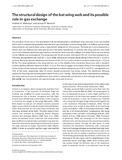| dc.contributor.author | Makanya, AN | |
| dc.contributor.author | Mortola, JP | |
| dc.date.accessioned | 2013-06-25T13:28:36Z | |
| dc.date.available | 2013-06-25T13:28:36Z | |
| dc.date.issued | 2007 | |
| dc.identifier.citation | Makanya AN, Mortola JP.,The structural design of the bat wing web and its possible role in gas exchange,J Anat. 2007 Dec;211(6):687-97. Epub 2007 Oct 26. | en |
| dc.identifier.uri | http://www.ncbi.nlm.nih.gov/pubmed/17971117 | |
| dc.identifier.uri | http://erepository.uonbi.ac.ke:8080/xmlui/handle/123456789/39796 | |
| dc.description.abstract | The structure of the skin in the epauletted fruit bat (Epomophorus wahlbergi) wing and body trunk was studied with a view to understanding possible adaptations for gas metabolism and thermoregulation. In addition, gas exchange measurements were performed using a respirometer designed for the purpose. The body skin had an epidermis, a dermis with hair follicles and sweat glands and a fat-laden hypodermis. In contrast, the wing web skin was made up of a thin bilayered epidermis separated by a connective tissue core with collagen and elastic fibres and was devoid of hair follicles and sweat glands. The wings spanned 18-24 cm each, with about 753 cm2 of surface exposed to air. The body skin epidermis was thick (61 +/- 3 microm, SEM), the stratum corneum alone taking a third of it (21 +/- 3 microm). In contrast, the wing web skin epidermis was thinner at 9.8 +/- 0.7 microm, with a stratum corneum measuring 4.1 +/- 0.3 microm (41%). The wing capillaries in the wing web skin ran in the middle of the connective tissue core, with a resultant surface-capillary diffusion distance of 26.8 +/- 3.2 microm. The rate of oxygen consumption (VO2) of the wings alone and of the whole animal measured under light anaesthesia at ambient temperatures of 24 masculineC and 33 masculineC, averaged 6% and 10% of the total, respectively. Rate of carbon dioxide production had similar values. The membrane diffusing capacity for the wing web was estimated to be 0.019 ml O2 min(-1) mmHg(-1). We conclude that in Epomophorus wahlbergi, the wing web has structural modifications that permit a substantial contribution to the total gas exchange. | en |
| dc.language.iso | en | en |
| dc.publisher | University of Nairobi, | en |
| dc.title | The structural design of the bat wing web and its possible role in gas exchange. | en |
| dc.type | Article | en |
| local.publisher | Department of Veterinary Anatomy and Physiology, | en |

